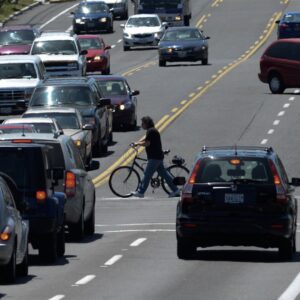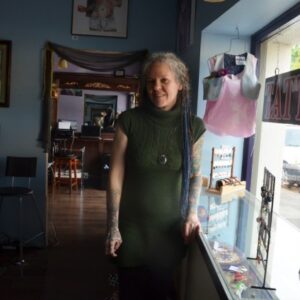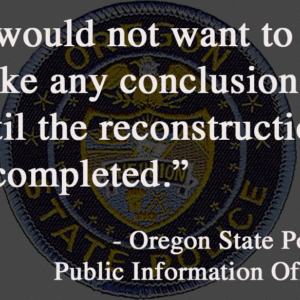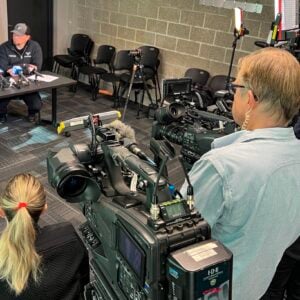
(Source: Oregon Walks Fatal Pedestrian Crash Report)
On Wednesday, Portland nonprofit Oregon Walks released their long-awaited Fatal Pedestrian Crash Report. Although it was the report’s top-line statistics about race, age, disability, and speed that rightfully dominated the news, among the report’s deeper insights is what it reveals about the politics of information gathering.
At the report’s heart are the forty-eight detailed reviews of pedestrian deaths which occurred between 2017 and 2019. Informing those reviews were thousands of pages of police reports which Oregon Walks has chosen not to publish out of respect for privacy. Collecting the voluminous data and analyzing the crashes was an all-volunteer effort led by Portland attorney Scott Kocher (a financial contributor to BikePortland). Their goal was to provide “a clearer picture of ‘what happened’ in particular crashes, identify the commonalities, trends and system failures that lead to fatal pedestrian crashes in Portland.” It was costly work both in money and time (the Portland Police Bureau is notoriously bad at releasing crash reports) and is not something most Portlanders have the expertise or means to do.
What becomes obvious reviewing the data is that the official crash reports are silent on the roadway deficiencies which may have contributed to the crash. Oregon Walks notes that “Police are generally focused on law enforcement, not engineering. Police reports generally provide little evaluation of infrastructure-related crash factors.”
Advertisement
A comparison of PPB and Oregon Walks reports
One typical example was a PPB crash report that was 42 pages long and included: a case summary, a narrative description of the scene, roadway evidence and distance measurements, interviews with multiple witnesses and the driver, cell phone evidence, video evidence, geometric calculations, driver blood sample, photographs and more. It was detailed, thorough and professional — all the evidence a District Attorney would need to take a case to trial, or to decide not to.
In contrast, at only three pages, the Oregon Walks review was pretty short. The very first sentence stated that the crash occurred in a “mid-block marked crosswalk,” a meaningful piece of information to someone wanting to understand “what happened,” or to make sure it doesn’t happen again. (In comparison, a search for “mid-block” or even “mid” in the PPB report found several occurrences of “LAST, FIRST, MIDDLE” but no hint of a mid-block crosswalk. Page 33, however, had a form with a tiny check mark next to the word “non-intersection.”)
The Oregon Walks review continued with recommendations for how to make the crosswalk more visible, a brief comment that the posted speed was incorrect per Portland’s speed Ordinance 188774, and noted possibly inadequate lighting.
In other words, it is an excellent roadmap for safety advocates and informative for the community in general, but it would probably be useless to a prosecutor.
Why it matters
“The testimony of people killed is unavailable in every crash. This means our information is fundamentally incomplete.” – Oregon Walks
It’s not that one report is better than the other, but they serve different purposes. The Portland Police focused on human actions and possible culpability, Oregon Walks looked at infrastructure inadequacies and possible improvements. Because the police report is usually the only official communication to the public about the crash, subsequent media reports often adopt the PPB culpability framing and focus on things like the color of the victims clothes, whether the driver cooperated with officers, if a person was wearing a helmet, and other behaviors. Infrastructure issues most often go unmentioned, and crash reporting does not usually attempt to understand the victim’s point of view.
In a comment both wry and grim, Oregon Walks noted that “the testimony of people killed is unavailable in every crash. This means our information is fundamentally incomplete.”
The recommendations
These observations have led the Oregon Walks report to make the following policy recommendations about data gathering and framing:
(Re)Establish a Fatal Pedestrian Crash Rapid Response Task Force Apparently a 2016 Vision Zero Action Plan called for a multi-agency rapid response team to evaluate fatal crash sites for safety enhancements,
PBOT participated in response to one crash, and then quietly abandoned this directive. Even if training or hiring is required, this team should exist, and should review the crash location at the time of the crash and collect data to improve PBOT’s safe systems approach.
Release Vision Zero fatal pedestrian crash media briefs
Shortly after each fatality crash, PBOT should release a Vision Zero crash media brief using media best practices for language and preliminary data from the rapid response task force location assessment to present a pedestrian focused, thematic-framed perspective of the crash.
Analyze Crashes and Provide Information to Communities
PBOT should develop templates and protocols to perform and publish reviews of every fatal and serious crash in Portland. These should be posted on PBOT’s Vision Zero Crash Map, along with the public record copy of the police report for each crash. Driver and victim last names and addresses may be redacted, consistent with PBOT’s currently-adopted “first name last initial” compromise between humanizing crashes and respecting families’ privacy.
The Focus Issues section of the report goes even further and recommends that PBOT should take over primary crash response:
In the interest of reducing police-public interactions and fostering a safe systems approach, PBOT should take over primary crash response. In depth crash reviews with a focus on infrastructure and engineering solutions as well as systems oriented press briefs should be made available to the public.
With its thousands of pages of raw police reports, and the hundreds of hours expert volunteers spent analyzing the data and writing alternate reviews, what the Oregon Walks report has shown is that information matters — who gathers it, who controls it, who frames it and how easily and well it flows to the public. Unless the policies around collecting and reporting crash information change, we won’t end the devastating human toll this report so powerfully illuminates.
UPDATE: 3/19/21, 8:27AM: Scott Kocher posted this comment about the ramifications of the “non-intersection” check on one of crash report forms:
It’s very likely that because the officer checked the “non-intersection” box that mid-block crosswalk crash is lumped in with other “non-intersection” crashes in official datasets, which is agencies’ shorthand for “ped’s fault.” The “non-intersection” shorthand also ignores the fact, in numerous crashes, that there was no marked or safer crossing at any intersection nearby. The “who was at fault” game not only misses the real point (which is that the conditions are a setup for any number of predictably tragic scenarios), its cursory conclusions are often wrong.
— Lisa Caballero, lisacaballero853@gmail.com
— Get our headlines delivered to your inbox.
— Support this independent community media outlet with a one-time contribution or monthly subscription.







Thanks for reading.
BikePortland has served this community with independent community journalism since 2005. We rely on subscriptions from readers like you to survive. Your financial support is vital in keeping this valuable resource alive and well.
Please subscribe today to strengthen and expand our work.
It’s very likely that because the officer checked the “non-intersection” box that mid-block crosswalk crash is lumped in with other “non-intersection” crashes in official datasets, which is agencies’ shorthand for “ped’s fault.” The “non-intersection” shorthand also ignores the fact, in numerous crashes, that there was no marked or safer crossing at any intersection nearby. The “who was at fault” game not only misses the real point (which is that the conditions are a setup for any number of predictably tragic scenarios), its cursory conclusions are often wrong.
We can never have enough research to inform policy. I applaud Oregon Walks who with volunteers put this report together. Truly amazing work.
The central problem, unfortunately, is not a lack of research (particularly if we look at international research as well), it is not a balance of safety and speed as some engineers believe. It is not a lack of money. It is not, as argued by PBoT’s VZ lead, a function of playing catchup: We just need more time for changes to take effect.
It is the inherently flawed and predictable process of evaluating and implementing projects. Any traffic engineer knows 12′ lanes on Hawthorne will increase the likelihood of speeding. The data on buffered vs protected bike lanes is clear, and yet we have an incredibly dangerous, newly reconstructed Foster. Williams was an experimental design that allowed more car capacity and parking at the expense of basic separated infrastructure. This safe pattern of political decisions add up to declining modal share and increase in death.
No amount of research will change PBoT’s decision making process, which is a clear pattern of prioritizing traffic counts and parking over basic safety measures. If you want to change Portland streets, change PBoT’s design process. Until that process changes via legislative mandates, a change of administration or otherwise, no street design will follow research.
It’s time for some turnover at PBOT. We have a “progressive” DOT that pretends to care about road safety and climate change while at the same time lying to us about the safety of their own roads, doing “experiments” that degrade the safety of ped and self-powered transportation and claiming bike lanes are bad for the environment. It’s not a design process problem, it’s a “fire your executive staff because they are out of touch with our needs” problem.
PBOT,PBOT, PBOT,PBOT!
ODOT,ODOT, ODOT, ODOT!
It’s always easy to blame bureaus and departments while continuing to vote for the politicians who have absolute power over their affairs.
My neighborhood doesn’t have enough money to be represented on the Portland City Council and our votes don’t matter. Believe me, I know that at the end of the day, it’s our electeds who are to blame, but as long as the West Hills and CEID decides who runs our broken city government, there isn’t much voting can do to change it.
I’m being too inexact. In my brain CEID refers to affluent close in housing, I actually forgot it refers to a defined area. I meant more the affluent population that lives close-in on the east side
You’re probably not wrong, which is all the more reason to get involved in the city charter review process happening right now. The City Club of Portland put down some excellent ideas for multi-member districts that would open up representation considerably – pair that with, say, tossing out plurality voting in favor of STAR voting and we might actually see some appropriately responsive city government in a cycle or two.
Whether that responsiveness goes in the direction we’d want is, of course, another discussion entirely…
Correct. If Hardesty applied the same amount of scrutiny to PBOT as she did the PPD, things would change very quickly. But it seems to me that, at least with Hawthorne, she had no idea what was really happening—partially because she’s brand new at the job, but also because nobody spoke up.
If Hardesty were to implement a policy that Wheeler opposed (e.g. something that upsets his corp-fascist supporters), PBOT would be yanked away from her in a heartbeat. Portland does not have a strong mayor system but it does have a very strong gaslighting mayoral system.
“she had no idea what was really happening”
Dog whistle.
From my experience speaking with her assistant concerning the project, she truly did not have a deep understanding of how the project was decided and why. I don’t think this is a fault on her part necessarily, but it does indicate 1) How much faith/independence she puts in PBoT decision making and 2) the discrepancy between Hardesty’s stated priorities on street safety and PBoT’s de facto street designs.
Exactly, this was also my takeaway from speaking with her assistant. I was also told that removing parking spaces was not one of Hardesty’s concerns at all (aside from maintaining some street seating spaces, ruling out a design that entirely eliminates parking, as opposed to the 50% reduction in Alternative 3b), which makes it all the more apparent that she was duped by PBOT’s lies about transit delay.
“her assistant”
The argument that Hardesty “had no idea what was happening” despite her many years of service on transportation Policy in East Portland is a really bad take. And the fact that this is entirely based on some random conversation with an “assistant” makes it even worse.
To be blunt, I feel that some active transportation activists have transferred their hostility from Eudaly to Hardesty despite the fact that both are/were progressives when it comes to transportation alternatives.
“the discrepancy between Hardesty’s stated priorities on street safety and PBoT’s de facto street designs.”
Commissioner Hardesty’s public comments seem completely on-target with her stated priorities, the TSP, and PBOT’s priorities.
Hardesty in an interview here on BP:
“To widen the street so that a variety of transportation options would be available for people. (Note: PBOT made it clear from the start widening the street was never an option due to the project scope.) Hawthorne is one of the smallest streets that we have in the city of Portland. And today you take your life in your hands with any mode of transportation. I have been one of those people, sitting on a bus for a half-hour crawling up Hawthorne. I’ve been one of those people trying desperately to cross the street on Hawthorne during a busy time of day. But it’s also a street where there’s a lot of foot traffic. And I know that a biking community would love to see a bike lane. If there was a way to do that and make sure that people with disabilities would be able to safely cross, that cars and public transit would be able to safely cross, if we were actually redesigning Hawthorne, those would be my priorities. But remember, this is not a redesign. This is a maintenance project — specifically to ensure that pedestrian safety is increased.”
Like Hardesty, my preference was for Rose lanes (would have required lane widening) but this was not possible for what was essentially a maintenance project. Like Hardesty, I view the current compromise as the best outcome given the hard funding limits for this project.
Imagine thinking that Hawthorne, a six-lane highway, is “one of the smallest streets in the city” Talk about gaslighting from PBOT!
hardesty was almost certainly referring to the current narrow lanes but keep on assuming the worst — it’s a very good look for you all.
I have spent some time reviewing PPB police bicycle crash reports in the past (let’s say a decade ago); I felt like the data was woefully inadequate and IMO often misinterpreted, and I’m not sure much has changed for the better since then. TA or another org in NYC has also done some analyses, and I think there has been some research in VancBC as well.
Here is the transalt report on the NYPD VZ effort.
https://static1.squarespace.com/static/5cab9d9b65a707a9b36f4b6c/t/5ee8f8d32822595d488cacd5/1592326362642/Death_Danger_and_Ignoring_the_Data_How_the_NYPD_is_Getting_Vision_Zero_Wrong_2.pdf
Thank you for this, eawriste, I just quickly skimmed it and it looks real good. Next week I hope to get an interview out with a deputy district attorney, about enforcement.
Fantastic work Lisa. Really appreciate the effort.
Thanks, Lisa! With all respect to Jonathan’s work, this was one of the most interesting articles I’ve read on BikePortland. Your description of the difference between the Oregon Walks reports and the police reports highlights how important it is that we change how we respond to fatal crashes. I hope lawmakers, PBOT, and Portland Police take these recommendations seriously.
I’m glad you liked the article, Stormcycler, it benefits from the reflected light of Scott Kocher’s good ideas. I got about three quarters of the way up the fence with it, and luckily my boss was there to pull me up and over.
I don’t know if the choice of Fessenden was on purpose or not but that street is emblematic of Portland’s failure to implement Vision Zero. If PBOT actually utilized Vision Zero, they would have rapidly changed Fessenden after the collision. Instead, they did nothing and less than two years later yet another pedestrian was murdered by yet another speeding drunk driver. Only after we had a second preventable death did PBOT install the traffic calming measures that the community had been asking for.
Vision Zero doesn’t work when you aren’t actually committed to reducing traffic deaths.
Hi cmh89, Jonathan selected Fessenden, I’m going to assume he had a reason.
My estimate was that no more than 25% of bicycle-motor vehicle collisions resulting in police response, and often emergency medical response, over a 15-year period at N. Broadway/Flint/Wheeler were ever documented in PPB statistics or reports. I and others began routinely waiting for the police to finish their work, and then asking the officer to please write a report. Had bikeportland.org not started shining a glaring public light, publishing photos and eye-witness accounts, that multi-faceted problem intersection likely would not have been re-engineered to the extent that it has.
I asked one officer, after the cyclist was taken away in an ambulance, if he had issued the driver a citation. She had right-hooked at Flint the cyclist who was straight-bound on Broadway in the bike lane. He said, ‘No. It was his word against hers. The driver said she had her turn signal on and the cyclist said she did not.’ I said, ‘A turn signal does not confer right-of-way. The driver violated the cyclist’s right-of-way.’ The officer seemed confused.
Kudos to Scott and his team of volunteers for analyzing these fatal pedestrian crashes. My dream is that we could use this work to build a protocol and reassign some of the PPB budget to fund crash investigators to routinely respond to, analyze, and document all collisions between vulnerable road users and motor vehicle drivers, so we can see patterns emerge to inform action to prevent future injuries and fatalities.
Scott Kocher (and others) thank you for performing a holistic review (post injury / death roadway safety audits, RSAs)…part of the difficulty may be that a police department may not want to make their sister transportation department look poorly (and culpable to lawsuit), especially when its not a safety issue/ outcome that affects vehicle operators.
This is one of the critical points where Vision Zero efforts start to fall apart (or really never have a chance at success) in the US.
Good point. But then it raises another question–if PBOT takes over crash investigations, or participates on a multi-agency team–can it be relied on to be objective, especially in the case of crashes where poor street engineering was a factor?
Police aren’t a factor in crashes, other than in the very general sense that more enforcement might help reduce illegal driving. But street design is at least a factor in many crashes, and poor design (and poor maintenance, which is also PBOT) seems like it has been a major factor in quite a few.
I think you’re right that police may not want to be too critical of PBOT. It seems even more likely that PBOT investigators might be reluctant to say other PBOT staff’s performances contributed to a fatality.
So what is next?
I would suggest that this should be used to push for a truly independent roadway safety audit (RSA) commission that does this post injury incident analysis that can then address all the 5 E’s vs. just putting all/ most of the eggs into the education basket (‘tell those pedestrians / cyclists / VRUs, that its all up to them for their safety’ and drivers its was just an ‘accident’ so keep on trucking!.)